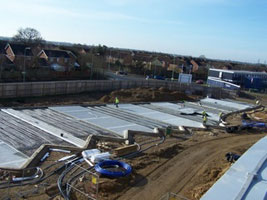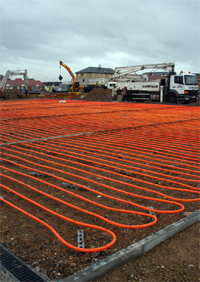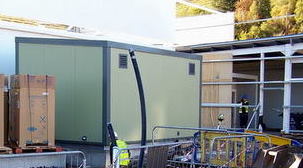Tesco Recycles Heat using Interseasonal Heat Transfer
by Duncan Osborne, Building Design & Construction magazine
ICAX is an independent company structured to provide turnkey heating and cooling to buildings based on Interseasonal Heat Transfer. It came into being in 1999 following a research programme that was conducted by Mark Hewitt and Andy Ford, who were providing a course in the North London Polytechnic on the efficient use of energy in buildings. That was the origin of the idea behind interseasonal heat transfer.
The Theory behind Interseasonal Heat Transfer
This process works by capturing heat energy from the sun via a collection pipe network just beneath the surface of black tarmac roads (or car parks or school playgrounds). It then stores the energy in computer-controlled Thermal Banks in the ground under the foundation of buildings, and releases it to heat the buildings in winter via heat pumps linked to underfloor heating.

The temperature of the ground at a depth of seven metres in the UK will normally be very close to 10°C – the temperature will vary very little between summer and winter as heat only moves very slowly in the ground. ICAX uses this characteristic of the ground to store heat from summer to winter. Using fluid – in an array of pipes – as the transport mechanism solves the difficulty of getting the heat into the ground – and out again.
The way in which heat is absorbed and released by the ground is complex and required to be studied using complex iterative methods that have only become practical with the use of computational fluid dynamics (“CFD”). The computer models developed by ICAX have since been tested in practical installations and refined to reflect empirical results. These have been used to refine the design parameters for successful Thermal Banks.
A Thermal Bank is used to store warm temperatures over a very large volume of earth for a period of months, as distinct from a standard heat store, which can hold a high temperature for a short time in an insulated tank.
It is a characteristic of earth that heat only moves very slowly through it – as slowly as one metre a month. ICAX has discovered how to input surplus heat into the ground over the summer months and extract that heat over the winter months for use in the space heating of buildings.
Coefficient of Performance
Most people think that if you put heat into the ground that it flows away like a river, but the interesting thing about the ground, is that heat moves through it very slowly, about a metre per month. The fundamental problem with ground source heat pumps is that people assume that they can take the heat out of the ground and it will magically flow back towards the pump. If you extract heat from the ground, the ground gets colder and therefore you have to pump harder in order to get heat out of the ground.
When you look at information about heat pumps on the web it will tell you that you can expect a coefficient of performance of 4 and the other thing is that you will have a constant temperature in the ground. It is worth analysing this, because the coefficient of performance of 4 means that for 1 kilowatt of electricity you get 4 kilowatts of heat. You will be most likely to get that at the beginning of the heating season in Autumn, but what is more important is the seasonal coefficient of performance, the number over the heating season. That is usually down at about 2.5 or 2.6 This is a more relevant number as it applies to the season as a whole and is very much less than the 4 that is usually quoted.
The other factor that is frequently quoted is the constant temperature of the ground. This is simply not true if you take temperature out of the ground. If you extract heat from the ground, the temperature of the ground around the pipes goes down.
Storing heat between seasons

Edward Thompson of ICAX makes an important observation about ground temperature: “If you go down on a midsummer’s day and go down six metres and take the temperature in, let’s say, in Hyde Park, you will find that the temperature at six metres is very close to 10° centigrade. If come back at midnight at Christmas Eve to the same place you will fond that the temperature is still 10° centigrade at 6 metres. The reason for this is that heat moves very slowly in the ground and seven metres down is far enough for the temperature to be constant if you don’t extract heat from the ground. If you do extract heat from the ground the temperature goes down and it can go down relatively quickly, very close to the pipes, but not very far from the pipes. So it is the discovery that heat moves vary slowly in the ground that we have turned on its head and used as an asset. The implication is that we can actually put heat into the ground in summer and it will still be there the following winter.”
Tesco at Greenfield, Oldham
The ICAX design for Interseasonal Heat Transfer at Greenfield provides cooling in summer by extracting heat from the supermarket and, instead of blowing this into the atmosphere like an air conditioning chiller, ICAX stores the heat in ThermalBanks in the ground.
When heating is needed in winter the ICAX system extracts the stored heat from the Thermalbank using a ground source heat pump and distributes it within the building. This recycling of waste heat through the Thermalbank, allows ICAX to deliver a significantly higher coefficient of performance than would be achieved by a traditional “unassisted GSHP”.
Recycling Thermal Energy
The ICAX Skid looks at the most cost effective energy source at any given time, and enables the transfer of heat from where it is available most easily to the areas of the building that need heat. If heat is not available from these sources the system looks to extract heat from the ThermalBank using a ground source heat pump. The natural energy system also has access to an air source heat pump for those spring days when the external air temperature is rising and the heat store in the ground is depleted at the end of the heating season. The ICAX Skid uses an intelligent approach to save energy and re-cycle heat whenever an opportunity arises.
Saving Energy
The IHT scheme underlines Tesco’s commitment to saving energy and lowering its carbon emissions. These are significant commitments from a large organisation and Tesco is continuously exploring the ways in which it can reduce the carbon footprint of its stores. As a global business Tesco recognises an important role in helping to minimise climate change. With the overarching goal to be a zero-carbon business by 2050.
A Turnkey Package
ICAX provides consulting services to advise on the design of ground source energy systems that can achieve long term sustainable heating and cooling systems. The advice is based on thermal models that have been developed by ICAX over many years of research to achieve thermal equilibrium. ICAX clients for these Thermal Modelling services have included Mott MacDonald, Tesco, Highways Agency, REHAU, Telford & Wrekin Borough Council, Merton Borough Council, and the European Union.
ICAX is a cleantech company helping to meet the demand for on-site renewable energy and sustainable development by using interseasonal heat stores to achieve low carbon buildings.
Clients are provided with a turnkey package for meeting sustainable energy targets on construction projects. ICAX undertakes design and installation to ensure that heating and cooling needs are met in a sustainable way. It also provides a complete range of services from initial feasibility through design and delivery, to in use maintenance.
www.icax.co.uk
Tel: 020 7253 2240
See also: TESCO chooses Interseasonal Heat Transfer to save energy
See also: Independent report on IHT by Transport Research Laboratories



